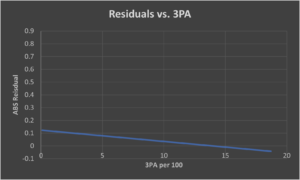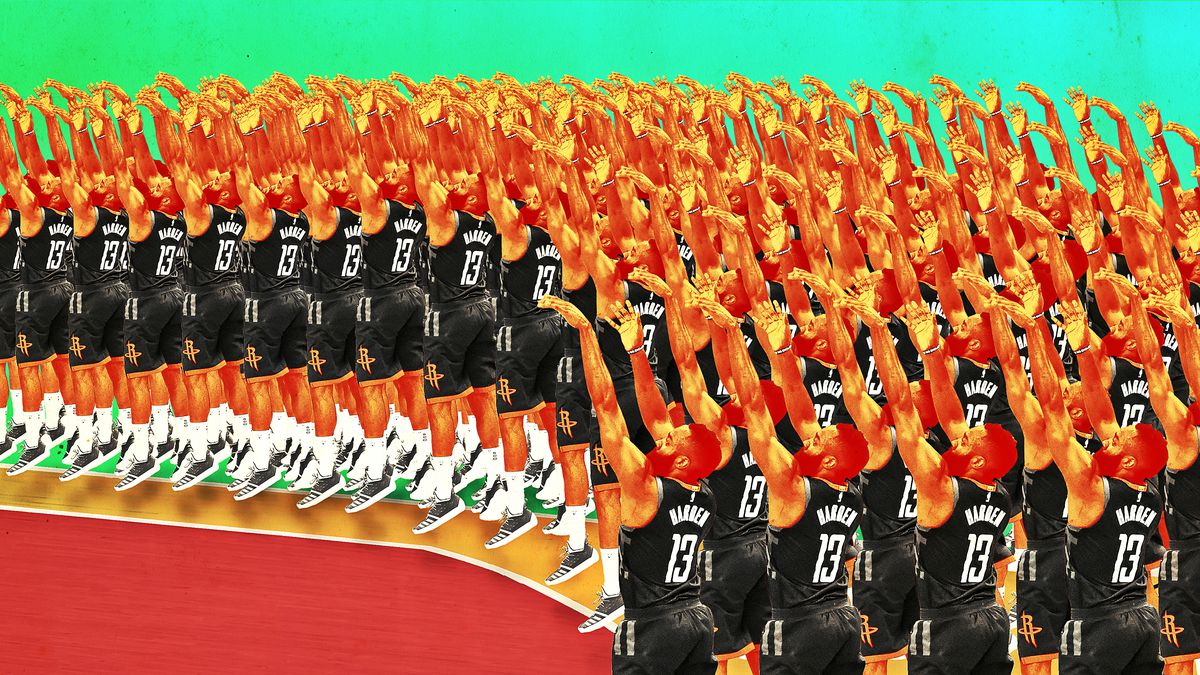(? The Ringer)
Tony Bradley, Drew Eubanks, and Johnathan Motley. What do these three players have in common? They each made 100% of their three-point attempts last season. Therefore, they must be the league’s best three-point shooters, right? No, of course not. Although the word “best” can have varying connotations here, it’s hardly appropriate to say three players who shot no more than 1.2 threes every 100 possessions were the best three-point shooters of the year. It’s been clear for a long time that conventional three-point percentage is, in essence, not a perfectly-indicative measurement. It pays no attention to the frequency at which a player shoots three-pointers. This has been combated with mental filtering for a while now, but what if there were a method to balance efficiency and volume in three-point shooting and condensed into one number?
Patrick Miller at Nylon Calculus tried to answer this question, specifically for college basketball players, to predict their three-point percentages in the NBA. His “Bayesian 3P%” was a success, appropriately pinpointing the three-point proficiency of college stars while providing accurate estimations of NBA percentages. Millers’ strong methodology and strong results had me thinking about the applications of Bayesian statistics in the NBA, and how they could improve the traditional measurement of three-point percentage, the result being a “prior-informed” three-point percentage or PI 3P%.
Methodology
As stated earlier, the goal of PI 3P% was to find a balance between efficiency and volume from beyond the arc to create an “adjusted” three-point percentage that accounts for a player’s shooting volume from that range. I retained the essence of Bayesian statistics in PI 3P% with the use of priors: previous beliefs on a subject used to improve the raw data, ours being three-point percentage. To do this, I regressed (logarithmically) the last twenty-five seasons of three-point attempts onto three-point percentage to provide a foundation for the prior; thus, accounting for diminishing returns on higher frequencies under the impression that three-point percentage becomes more and more indicative as a player takes more and more shots. All data in the regression were adjusted to “per-100.”
With the prior, I was able to estimate a player’s three-point percentage based on how often he shot from that range. The next step was to merge a player’s actual percentage with his expected percentage, but I also had to decide to how great a degree the latter would be weighed. This process was simply a lengthy test of observing how percentages change with different weightings and comparing residuals against three-point attempts. If the weighting was a success, then the residuals should decrease as attempts increase (below).

From a sample of last year’s data, we can see there’s a typical decrease in adjustments as a player’s frequency from three-point range increases. The prior serves the purpose of negating extremely-high percentages on low volume but also reduces the effects of anomalous results. Dusty Hannahs of the Memphis Grizzlies converted on 67% of his 10.8 three-point attempts per 100 possessions, a mark that lowers to a 46% prior-informed three-point percentage. This is an extreme instance, of course. Players’ updated three-point percentages will continue to represent great-shooting seasons with minor luck adjustments. That being said, adjusting for luck does not extend to playing time. Hannahs, the league’s leader in prior-informed 3P% last year, played a mere 13 minutes the entire year. PI 3P% is a descriptive statistic to measure a player’s three-point proficiency during his time on the court.
With our prior-informed 3P% up and running, can we still reasonably state the original trio of Tony Bradley, Drew Eubanks, and Johnathan Motley represents the league’s best distance shooters? This model strongly disagrees, with no player of the group posting a new percentage higher than 28%. Instead, we can select a new group of players in place of them. For players who were on the court for at least 1500 minutes last season, the top shooters in PI 3P% are:
- Duncan Robinson
- J.J. Redick
- Dāvis Bertāns
- Buddy Hield
- Seth Curry
This group is far more representative of the league’s top distance scorers, each of them having shot at least 9.8 attempts per 100 with an efficiency of at least 39%. Meanwhile, Tony Bradley, the sole member of our original trio to make the Playoffs, fell to 0% in the second season. With a prior-informed three-point percentage, we can reduce the need for mental filtering in determining the league’s best three-point shooters.
The database for PI 3P% can be found here.

Leave a Reply